Related Research Articles
Rock climbing is a popular activity in the Peak District; particularly on edges such as Stanage or Froggatt. Generally the climbing style is free climbing and the rock is either gritstone or limestone. Climbing has been practised in the Peak District since the late 19th century; James W. Puttrell is generally credited with starting the sport. The first climbing guidebook to the area was Some Gritstone Climbs, by John Laycock, published in 1913. There are over 10,000 routes in the Peak District. One of the most famous Peak District climbers, and a pioneer of many new routes, is Ron Fawcett. The climb known as "Master's Edge", on Millstone Edge, near Hathersage, is a testament to his skill and strength. The climb is graded E7 6c and rises 19m up the near vertical edge.
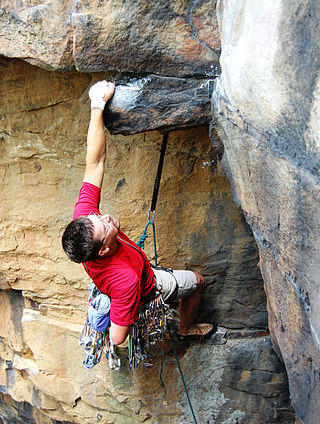
Traditional climbing is a type of free climbing in rock climbing where the lead climber places the protection equipment while ascending the route; when the lead climber has completed the route, the second climber then removes the protection equipment while climbing the route. Traditional climbing differs from sport climbing where the protection equipment is pre-drilled into the rock in the form of bolts.

Solo climbing, or soloing, is a style of climbing in which the climber climbs a route alone, without the assistance of a belayer or being part of a rope team. By its very nature, solo climbing presents a higher degree of risk to the climber, and in some cases, particularly where the climber is also not using any form of climbing protection, it is considered an extremely high-risk activity.
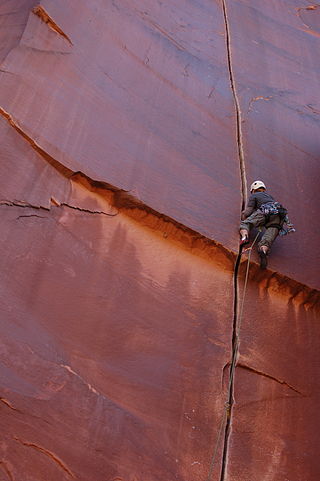
Rock climbing is a climbing sports discipline that involves ascending routes consisting of natural rock in an outdoor environment, or on artificial resin climbing walls in a mostly indoor environment. Routes are chronicled in guidebooks, and on online databases, with the details of how to climb the route, and who made the first ascent and the coveted first free ascent. Climbers will try to ascend a route onsight, however, a climber can spend years projecting a route before they make a redpoint ascent.

Fair Head or Benmore is a 5-kilometre (3.1 mi) long, 200-metre (660 ft) high, mountain cliff, close to the sea, at the north-eastern corner of County Antrim, Northern Ireland. The cliff's sheer and vertical 100-metre (330 ft) high dolerite rock face is shaped into distinctive vertical columns like organ pipes, which formed 60 million years ago when a sill of igneous rock was injected between horizontal Carboniferous sediments.

Johnny Dawes is a British rock climber and author, known for his dynamic climbing style and bold traditional climbing routes. This included the first ascent of Indian Face, the first-ever route at the E9-grade. His influence on British climbing was at its peak in the mid to late-1980s.
Steve McClure is a British rock climber and climbing author, who is widely regarded as Britain's leading and most important sport climber for a period that extends for over two decades, starting from the late 1990s. In 2017, he created Rainman, Britain's first-ever 9b (5.15b) sport route, and by that stage was responsible for developing the majority of routes graded 9a (5.14d) and above in Britain. Although mainly known for sport climbing, McClure has also been one of the most successful British traditional climbers, and British onsight climbers.
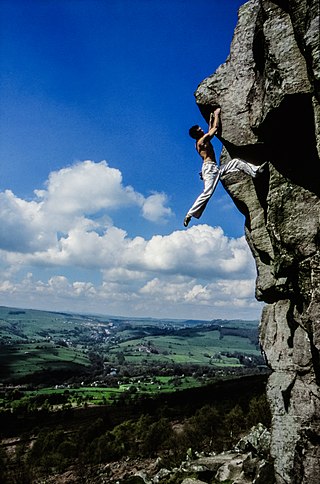
Jerry Moffatt, is a British rock climber and climbing author who is widely considered as being the best British rock climber from the early-1980s to the early-1990s, and was arguably the best rock climber in the world in the mid-1980s, and an important climber in the history of the sport.
Pete Livesey, was an English rock climber who raised the standard of technical difficulty in traditional climbing in Britain during the early to mid-1970s. Livesey was renowned for the intensity and competitiveness he brought to the development of his sport as well as a mischievous sense of humour, and during the mid-1970s, Livesey was regarded as Britain's leading rock climber.

Master's Edge is an 18-metre (59 ft) traditional climbing route on a gritstone arête in the "Corners Area" of Millstone Edge quarry, in the Peak District, England. When English climber Ron Fawcett completed the first free ascent of the route on 29 December 1983, it was graded E7 6c, and one of the hardest traditional climbing routes in the world; it remains one of the hardest gritstone climbs.
Lisa Rands is an American rock climber. She is known for her bouldering for which in 2002, she became the first American female to win IFSC World Cup bouldering competitions, and topped the IFSC world boulder rankings in 2002. Rands was the first American female to climb boulders of grade V11 (8A), and V12 (8A+), and was the second-ever female in history to climb a 7C+/8A boulder. As well as making first female ascents (FFAs) of boulders such as The Mandala V12 (8A+), Rands was the first female in history to do an E8-graded traditional climbing route, The End of the Affair.

In the history of rock climbing, the three main sub-disciplines – bouldering, single-pitch climbing, and big wall climbing – can trace their origins to late 19th-century Europe. Bouldering started in Fontainebleau, and was advanced by Pierre Allain in the 1930s, and John Gill in the 1950s. Big wall climbing started in the Dolomites, and was spread across the Alps in the 1930s by climbers such as Emilio Comici and Riccardo Cassin, and in the 1950s by Walter Bonatti, before reaching Yosemite where it was led in the 1950s to 1970s by climbers such as Royal Robbins. Single-pitch climbing started pre-1900 in both the Lake District and in Saxony, and by the late-1970s had spread widely with climbers such as Ron Fawcett (Britain), Bernd Arnold (Germany), Patrick Berhault (France), Ron Kauk and John Bachar (USA).
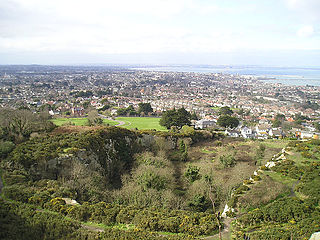
Dalkey Quarry is a long-disused 19th century granite quarry located on Dalkey Hill in the Dublin suburb of Dalkey, which was used to build several large maritime structures in south Dublin. Since passing into public ownership in the early 20th century and becoming part of Killiney Hill Park, it has become one of the most important rock climbing venues in Ireland, with over 350 graded routes, some of which are amongst the hardest single-pitch rock climbs in the country such as Indecent Assault. The climbs are all traditional climbing routes and no bolted sport climbing routes are permitted, although some metal pegs are tolerated on the most extreme routes.

Ailladie, is an 800-metre-long (2,600 ft) west-facing limestone sea cliff, that varies in height from 8 metres (26 ft) to 35 metres (115 ft), situated on the coast of The Burren in County Clare, Ireland. Ailladie is one of Ireland's most highly regarded rock-climbing locations, particularly for high technical grade single pitch traditional climbing routes and deep-water soloing routes. It is also a location for shore-angling competitions, and, with its cliffs and view of the Aran Islands, is a popular photography stop for tourists.
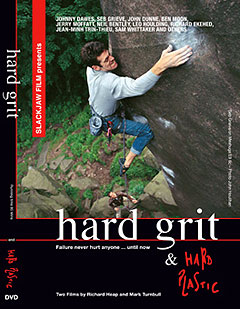
Hard Grit is a 1998 British rock climbing film directed by Richard Heap and produced by Slackjaw Film, featuring traditional climbing, free soloing, and bouldering on gritstone routes in the Peak District in Northern England. It is considered an important film in the genre and regarded as a historic and iconic film. The film starts with a dramatic fall by French climber Jean–Minh Trinh-Thieu on Gaia at Black Rocks. Hard Grit won ten international film festival awards.
Malcolm Smith is a Scottish rock climber and competition climber who won the bouldering IFSC Climbing World Cup in 2002.

Dinas Cromlech or Dinas y Gromlech is a distinctive rhyolite rock outcrop at the Llanberis Pass, in Snowdonia, northwest Wales, which has a distinctive "open book" shape that is clearly visible from the road (A4086), and is very popular location for rock climbers and contains some of Britain's most famous and notable rock climbing routes, several of which are important in the history of rock climbing.
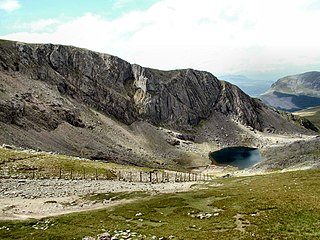
Indian Face is a 45-metre (148 ft) traditional climbing route on the rhyolite "Great Wall" of the East Buttress of Clogwyn Du'r Arddu, in Wales. When English climber Johnny Dawes completed the first free ascent of the route on 4 October 1986, it was graded E9 6c or, the first-ever E9-graded route, and was considered one of the hardest traditional climbing routes in the world.
Robert Andrew Pollitt was a British rock climber who was one of the most prominent traditional climbers and sport climbers of the late 1980s and early 1990s. In 1992, after having successfully repeated Punks in the Gym in Australia, the world's first-ever 8b+ (5.14a) graded sport climbing routes, he quit climbing and permanently emigrated to Australia. In 2016, Pollitt published an autobiography, titled Punk in the Gym. He died from a cerebral aneurysm on 13 November 2019.
References
- 1 2 3 4 5 6 7 8 9 10 11 12 13 14 15 Haston, Steve (30 March 2010). "Stevie Haston Reviews Ron Fawcett's New Book". UKClimbing.com. Retrieved 5 January 2022.
- ↑ Tate, Leslie (21 November 2019). "A Craven diary: Rock climber who grew up in Embsay". Craven Herald & Pioneer. Retrieved 7 January 2022.
- 1 2 Pearsons, Neil (2011). "Abandon all rope (Part 1)". The Guardian . Retrieved 6 January 2022.
- 1 2 Lucas, James (2011). "Ron Fawcett Rock Athlete". American Alpine Club . Retrieved 6 January 2022.
- 1 2 Thompson, Simon (March 2012). Unjustifiable Risk?: The Story of British Climbing. Cicerone Press. ISBN 978-1852846794.
Fawcett would dominate British climbing for a decade
- ↑ Ryan, Tony (2 March 2010). "Ron Fawcett autobiography". British Mountaineering Council . Retrieved 6 January 2022.>
- ↑ "Fawcett Tells All in New Book". Gripped.com. 26 February 2010. Retrieved 6 January 2022.
- 1 2 Jerry Moffatt (2020). Jerry Moffatt Revelations. Vertebrade. ISBN 978-1906148195.
It's Ron Fawcett!' He said this in a loud whisper, his voice almost cracking with emotion. 'It's RON FAWCETT!' My God! We all ran after the boy and hid in a bush where we could watch. Ron Fawcett was the biggest legend in British climbing.
- 1 2 3 Milani, Alberto "Albertaccia" (19 January 2018). "Cimbing Here: Ron Fawcett". UP-Climbing. Retrieved 6 January 2022.
- ↑ "Andy Pollitt & 'Big' Ron Fawcett: Interview". UKClimbing.com. 2017. Retrieved 6 January 2022.
- 1 2 3 4 5 6 7 "Ron Fawcett - The Fingertip Phenomenon". PlanetMountain.com. 19 March 2016. Retrieved 6 January 2022.
- ↑ Osius, Alison (27 April 2022). "Free Soloing Means No Rope. These Climbers Have Defined the Pursuit". Climbing . Retrieved 27 May 2022.
- ↑ Pearsons, Neil (2011). "Abandon all rope (Part 2)". The Guardian . Retrieved 7 January 2022.
- ↑ Fawcett, Ron (16 February 2010). "Ron Fawcett talks about Soloing". UKClimbing.com. Retrieved 7 January 2022.
- ↑ McDonald, Dougald (26 June 2014). "100 5.10 and 5.11 Solos in One Day in England's Mountains". Climbing . Retrieved 7 January 2022.
- 1 2 Oviglia, Maurizio (23 December 2012). "The evolution of free climbing". PlanetMountain.com. Retrieved 4 January 2022.
- 1 2 "Mina Leslie-Wujastyk makes first female ascent of Careless Torque at Stanage". PlanetMountain.com. 21 March 2013. Retrieved 6 January 2022.
- 1 2 Hutton, Mike (12 November 2019). "No-Bolt Roulette: The Evolution of Headpointing on Peak District Gritstone". Climbing . Retrieved 6 January 2022.
- ↑ Gardiner, Tina (24 November 2010). "Ron Fawcett Rock Athlete wins Boardman Tasker". British Mountaineering Council . Retrieved 6 January 2022.
- ↑ "Ron Fawcett old style on Lord of the Flies, E6 6a". UP-Climbing. 22 March 2020. Retrieved 6 January 2022.
- ↑ "Twyford fires Strawberries". Climber. 5 October 2014. Retrieved 6 January 2022.
- ↑ Messenger, Alex (18 June 2014). "Sweet taste of Strawberries for Steve McClure". British Mountaineering Council . Retrieved 6 January 2022.
- ↑ "Hansjörg Auer onsights Strawberries at Tremadog". PlanetMountain.com. 29 May 2012. Retrieved 6 January 2022.
- ↑ Farqhar, Grant (30 November 2018). "Mission Impossible: British Climbing's Great Challenges". UKClimbing.com. Retrieved 6 January 2022.
- ↑ "Millstone Area". Eastern Edges: North - Burbage, Millstone and Beyond Paperback. The British Mountaineering Council. 2006. ISBN 978-0903908771.
- ↑ "Ron Fawcetts 100 extremes in a day ticklist". UKClimbing.com. February 2013. Retrieved 6 January 2022.
- ↑ Levy, Michael (29 November 2018). "The Glorious Inanity of the Girdle Traverse". Rock & Ice . Retrieved 6 January 2022.
- ↑ Whittacker, Peter (1 September 2007). "Complete traverse of Stanage". British Mountaineering Council . Retrieved 6 January 2022.